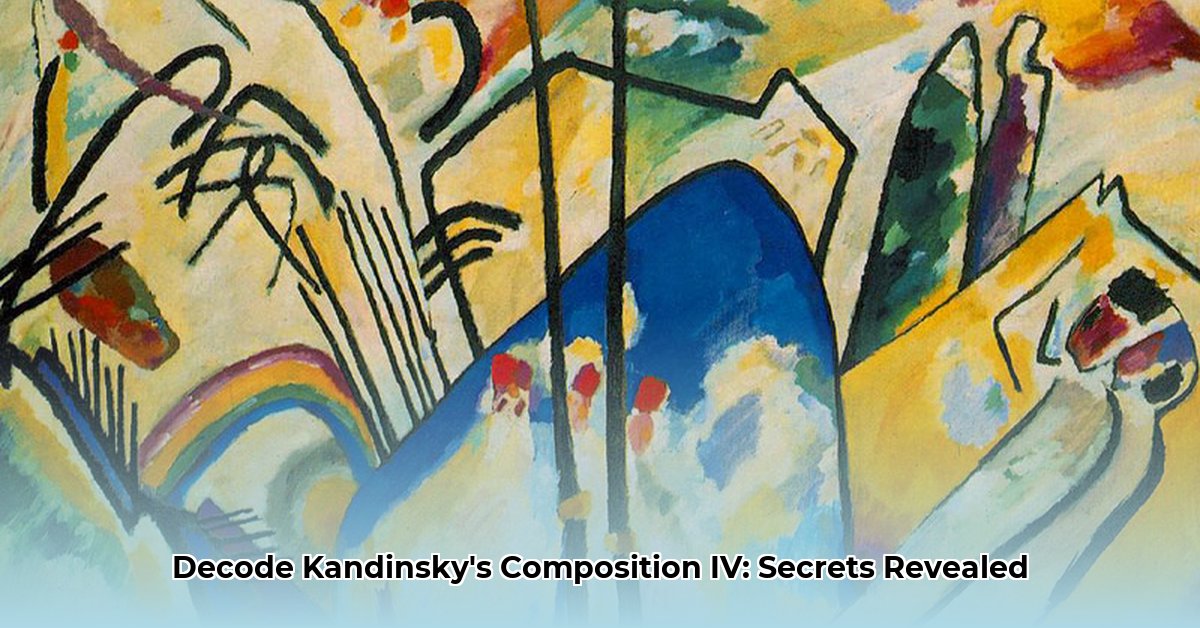
Composition IV: A Visual Symphony of Movement and Stillness
Wassily Kandinsky's Composition IV (1911) transcends mere visual representation; it's a dynamic, almost visceral experience. A swirling vortex of color and form, it challenges the viewer with a potent blend of energy and tranquility. This essay delves into the multifaceted aspects of Composition IV, exploring its formal elements, historical context, and the ongoing debate surrounding its interpretation. The painting's power lies not in a singular, easily defined meaning, but in its capacity to evoke diverse emotional and intellectual responses, making it a seminal work of abstract expressionism. How does Kandinsky achieve this remarkable effect? Let's explore. For a deeper dive, check out this Composition IV analysis.
A striking feature of Composition IV is its palpable energy. The painting pulsates with a life of its own, a dynamic interplay of sharp lines and softer shapes, bold colors both harmonizing and clashing in a captivating visual rhythm. This immediately draws the viewer into its complex narrative, demanding close attention and active engagement. What fuels this intense visual force?
The Dance of Opposites: A Key to Understanding Composition IV
Kandinsky masterfully employs contrasting elements to create this profound visual tension. Heavy blocks of color act as weighty musical notes, interacting with lighter, more dynamic lines that zip across the canvas like a nimble melody. Warm, vibrant colors ignite the painting, while cooler tones provide a necessary counterpoint, creating a harmonious yet chaotic visual rhythm. This deliberate imbalance, as Kandinsky himself noted in his writings, generates a sense of dynamic movement and, paradoxically, a compelling sense of underlying unity. This balanced tension significantly contributes to the painting's impact – a controlled burst of creativity that is both exhilarating and strangely calming. This is not merely visual; it's a sensory experience. Don't you find yourself drawn into this internal conflict of motion and stillness?
Deconstructing the Elements: Color, Line, and Form
To fully appreciate Composition IV, we must dissect its key components:
Color: Kandinsky’s color palette isn't merely decorative; it evokes potent emotions and sensations. The bold reds, blues, and yellows pulse with energy, contrasted by calmer, cooler tones. This interplay creates a complex emotional landscape, inviting diverse interpretations depending on the viewer's individual sensitivities and experiences.
Lines: The lines are remarkably varied, ranging from bold, assertive strokes that guide the eye across the canvas, to softer, more suggestive lines hinting at movement. This prevents monotony and enhances the painting's dynamic quality. What paths do you trace with your eyes as you traverse this visual terrain?
Forms: The abstract shapes aren't arbitrary; they possess inherent weight and meaning. Their interaction forms a visual narrative that unfolds gradually upon closer examination. The overlapping contours create depth and layers, challenging the viewer to actively participate in uncovering the painting's secrets. Each element plays a crucial role in the whole, much like instruments in an orchestra.
The relationships between these elements form a complex visual interplay, akin to a musical composition. This constant dialogue between different elements is the source of the painting’s power. Considering the complex interplay of color, line and form, how does this contribute to the overall message of Composition IV?
Beyond the Visual: A Multi-Sensory Experience
Kandinsky's belief in synesthesia—the blending of senses—is crucial to understanding Composition IV. He believed colors possessed inherent sounds, and shapes held emotional significance. The painting isn't simply a visual experience; it’s multi-sensory, akin to listening to a vibrant symphony while feeling its rhythmic pulse. This adds a unique, deeply engaging layer to the artwork. Does this multi-sensory interpretation enrich your own experience of the painting?
Open to Interpretation: The Enduring Power of Abstraction
However, the beauty of abstract art lies in its open-endedness. Composition IV doesn't offer a singular, definitive meaning. Instead, it invites personal interpretation, encouraging viewers to engage with it on their own terms and derive their own unique meaning. What does Composition IV communicate to you? The diversity of interpretations is a testament to the painting's enduring power and its relevance across time and cultures. This open interpretation is a defining characteristic of abstract art.
The Evolving Legacy of Composition IV
This analysis only scratches the surface of Composition IV's rich complexity. Further research, new perspectives, and the ongoing dialogue surrounding the artwork continue to enrich our understanding. The evolution of its interpretation is a testament to its enduring relevance and its capacity to inspire ongoing artistic and intellectual exploration. This makes Composition IV not just a static artifact, but a living, breathing work of art that engages with each generation anew.